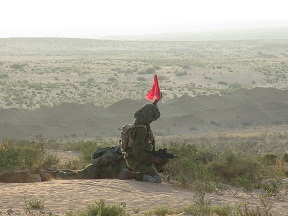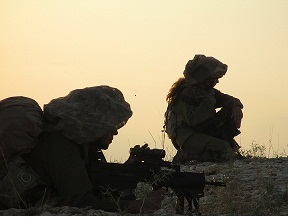Advancing to Victory: A Live Fire Exercise
A company of the mixed-gender Caracal infantry battalion completes the most important exercise of their training.
It was late in the afternoon but the midday heat lingered. In their dusty camp, one company of the mixed-gender Caracal battalion were preparing for war: strapping on their vests, filling their canteens, loading their magazines. The officers were reviewing how this support company would take the position from the enemy, their strategy written with chalk, circles and flags in the sand.
“This is a war game,” explains Lt. Gal Shefer, while helping another soldier prepare his vest. “This is the most important and exciting part of training. This is what they drafted for.”
There was talk among the ranks that the drill they’d been waiting all year to do might get cancelled due to the heat. This was meant to simulate a real war though, and heat or no heat, the show would go on.
![]()

Out in the desert, the men and women stand shoulder to shoulder in a circle, the Israeli-made Tavor gun slung around their shoulders. In the center, the company commander is reviewing the importance of safety for one last time: this exercise will be done with live fire.
As the company commander finishes, one soldier can’t hold himself back: “This is a once in a lifetime experience. Let’s give it our maximum.” Shouts of “YALLA!!” go around, and the soldiers put in their earplugs.
Each unit disperses to their battle stations. The imagined enemy is situated within two large plateaus like twin mountain peaks about a quarter of a mile off in the distance.
The Advance
![]()

Scout teams approach the plateaus from the left and the right. Behind them are teams of snipers and machine guns, and behind these are the mortars. The scouts advance in bursts and waves, with the heavy ammo providing cover fire. No team remains in the rear for more than a minute
The red and blue flags of each team mark the fronts and ends and communicate orders. From afar, flags tell the story.


The company is split between the left Down and up the paths, side by side, lapping and overlapping, the different teams coordinate like a nervous system: little parts communicate with others to lead a vast system towards one goal. For the nervous system it’s pain; for the soldiers of Caracal it’s victory.
The company is split between the left flank and right flank, but they advance at an even pace. One team runs while another crouches or lies in the rear, ready to give cover fire.
To conquer the elevated plain, there is no other way but to climb. The leading scouts fall onto the rocky land, some ripping the uniform at the knees, and crawl their way to the enemy. It takes five grueling minutes, moving inch by inch by digging knees and elbows into rocky slopes. Momentarily the scouts disappear behind the plateaus, and soon thereafter reappear along a connecting ridge. When the teams meet, it means the drill is over – the enemy position is conquered.
First Dry Then Wet
“These types of drills are always done twice. Once dry and once wet,” explained Staff Sgt. Karen Silberman, using the IDF terms for non-live (dry) and live fire (wet) drills. This drill was done twice, with only a ten minute resting period in between.


“But obviously in war,” the Staff Sgt. added, “we don’t have such a luxury. We’ll fight in a place we’ve never trained before, and we can’t use flags during a battle because the enemy will understand what we intend to do.
Though they can’t simulate all the unknowns of war, the drill is absolutely necessary, asserted Staff Sgt. Silberman. “This is how we learn to work with each other.”

